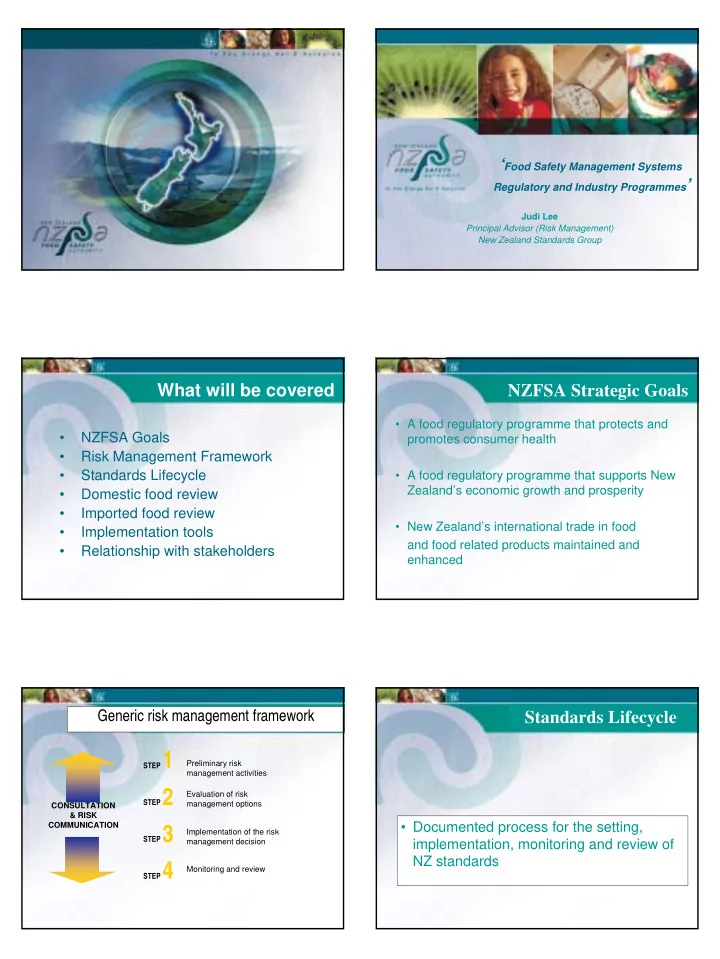

‘ Food Safety Management Systems Regulatory and Industry Programmes ’ Judi Lee Principal Advisor (Risk Management) New Zealand Standards Group What will be covered NZFSA Strategic Goals • A food regulatory programme that protects and • NZFSA Goals promotes consumer health • Risk Management Framework • Standards Lifecycle • A food regulatory programme that supports New Zealand’s economic growth and prosperity • Domestic food review • Imported food review • New Zealand’s international trade in food • Implementation tools and food related products maintained and • Relationship with stakeholders enhanced Generic risk management framework Standards Lifecycle STEP 1 Preliminary risk management activities STEP 2 Evaluation of risk management options CONSULTATION & RISK • Documented process for the setting, COMMUNICATION STEP 3 Implementation of the risk management decision implementation, monitoring and review of NZ standards STEP 4 Monitoring and review
Standards Lifecycle Framework What is a standard? • Standard: – Regulatory requirements (legislated or enabled by legislation) – Implementation requirements (e.g. Codes of Practice, Templates) Intelligence Gathering Option Development Option Consideration Decision Making
Standard Development Operationalise Business as Usual Monitoring and Review Domestic Food Review Progress • Largely completed “Policy development” phase • Commenced in 2003 • Entering “Legislation” and “Implementation” phases • Purpose – a regulatory food programme that • New Food Act by 2008 applies to all foods and will deliver on & • Complete implementation by 2013 promote safe & suitable food into the future
Proposed Import Regime Policy • Principles to underpin legislation Key features: – minimising costs • responsive and flexible – regulatory model • based on sound risk management – basis for regulatory controls decision making – persons taking responsibility • shifts emphasis away from stand- – consistent requirements alone border testing to exporting – seamless/coherent programme country assurances and considering – facilitate trade post-border controls. Import Management Decision Making Overview of Proposed Regime Framework (IMDMP) Scope: Reflects NZFSA’s risk management • proposed design applies to all foods covered framework. by legislation administered by NZFSA • includes ACVMs - current controls not Provides systematic process to: replaced but improved and modified where appropriate - intervention at most appropriate • evaluate food safety risks and other place (pre-border, border, post border) factors • determine level of regulatory interest • all importers who import food for commercial purpose. • prioritise the development or review of standards. IMDMP IMDMP Key components: • Underpinned by sound science and risk analysis • Import Risk Ranking and Prioritisation Model • risk profiles / risk assessments to • 3 categories of regulatory interest assist with making risk management • standards applying to each category. decisions.
Import Risk Ranking and Prioritisation Application of Import Model Model Import Model: Initial work: • developed from expert elicitation data • use model to categorise all foods into • ranking based on known food safety risks one of 3 regulatory interest categories • prioritisation to enable other legitimate - high, medium, low factors to be considered when categorising foods • model refined during initial work. • ranking and prioritisation will determine into which regulatory interest category each food is placed. Import System components Implementation tools The Import System will comprise: • registration requirements • Food Control plans • national imported food programme (NIFP) • Food Controls Plans (management tools • National programmes for importers) • a pre-clearance programme to develop • Food Handler Guidance and review pre-clearance arrangements • approvals and verification processes. Food Control Plans Components of an FCP • Responsibilities and authorities • Scope • Requirements • Procedures for good operating practice (GOP) • a risk based management plan • Application of HACCP principles • covers safety and suitability • Internal Verification • documents how food standards will be met • External verifier rights • responsibility of the operator • Documentation & record keeping procedures
Developing an FCP Off-the-peg Can be developed in two general ways: • NZFSA developed and approved for sector • off-the-peg • requires only minimal tailoring for use • comes with guidance material • custom-made Custom-made Off-The-Peg Criteria Criteria covered: • technical capability of the food sector • commonality of processes • Developed by individual food business • resource capability of the food sector • Guidance material available A model was used to process the criteria. National Programmes Food Handler Guidance • developed by NZFSA •non regulatory • legally based •guidance and education focused • control some or all food safety or •covers essential requirements for suitability issues food safety and suitability • cover all or part of a particular sector •simple, clear • are in a particular part of a food •distributed from Territorial Authorities chain
Legislative Alignment Food Handler Guidance Criteria to determine eligibility: • small sphere of impact • lower end of risk scale • Food Act 1981 • community involvement or fundraising • ACVM Act 1997 • minimal operational frequency • Animal Products Act 1999 with new Food Act 2007-08 Relationship with Stakeholders Our website • Academia Look out for updates at our • Food Sector Associations website: • Importers Forum http://www.nzfsa.govt.nz • Research Institutions • Other Government agencies • Consumer Forum
Recommend
More recommend